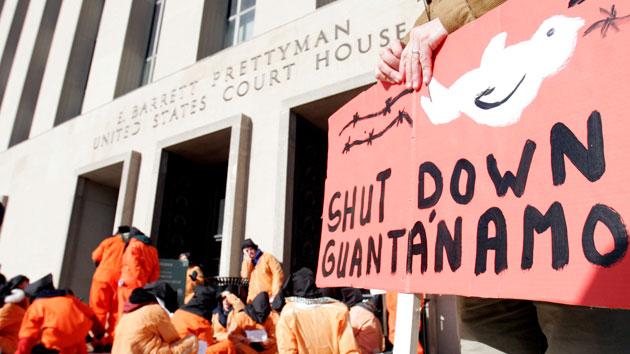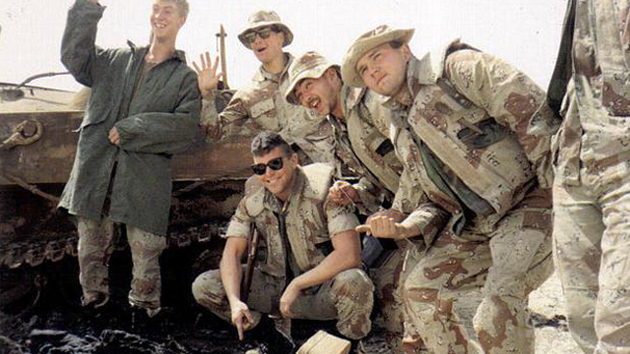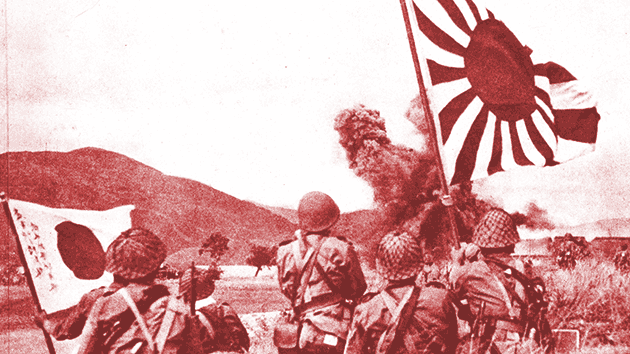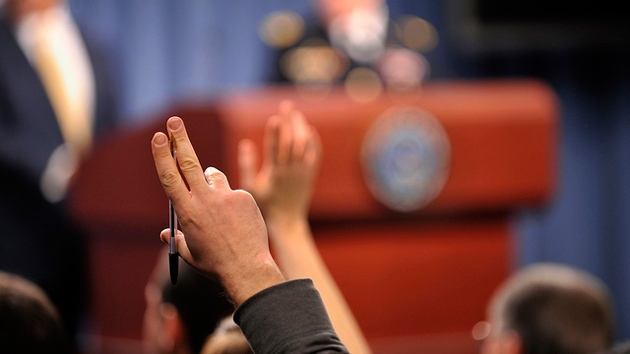
Caleb Jones/AP
This story first appeared on the TomDispatch website.
Why was it again that, as President Obama said, “we tortured some folks” after the 9/11 attacks? Oh, right, because we were terrified. Because everyone knows that being afraid gives you moral license to do whatever you need to do to keep yourself safe. That’s why we don’t shame or punish those who were too scared to imagine doing anything else. We honor and revere them.
Back in August 2014, Obama explained the urge of the top figures in the Bush administration to torture “some folks” this way: “I understand why it happened. I think it’s important, when we look back, to recall how afraid people were when the twin towers fell.” So naturally, in those panicked days, the people in charge had little choice but to order the waterboarding, wall-slamming, and rectal rehydration of whatever possible terrorists (and innocents) the CIA got their hands on. That’s what fear drives you to do and don’t forget, at the time even some mainstream liberal columnists were calling for torture. And whatever you do, don’t forget as well that they were so, so afraid. That’s why, says the president, “It’s important for us not to feel too sanctimonious,” too quick to judge the people in the Bush administration, the CIA, and even the US military who planned, implemented, and justified torture.
The president has vacillated about just how long this period of exculpatory fear was supposed to last. Sometimes he seems to suggest that it’s just the responses in the more or less immediate aftermath of those attacks we shouldn’t feel too sanctimonious about. Sometimes it’s all those “years after 9/11” during which America’s leaders had to face “legitimate fears of further attacks” and therefore kept on torturing people.
However long the panic lasted, the important point is that, as Obama insisted in 2009, and again at the end of 2014, no one should be prosecuted for torture, because everyone was scared.
Anyone in President George W. Bush’s position would have declared that the Geneva Conventions, which are supposed to protect prisoners of war from mistreatment, don’t cover prisoners taken in the “war on terror.” Anyone would have told the pundits on “Meet the Press,” as Vice President Dick Cheney did less than a week after 9/11, that the attacks meant we would now have to work “the dark side.” Anyone in CIA Director George Tenet’s shoes would have agreed with Cheney when he said that “a lot of what needs to be done here will have to be done quietly, without any discussion, using sources and methods that are available to our intelligence agencies.”
And any attorney in the Justice Department’s Office of Legal Counsel would naturally have written the “torture memos” that John Yoo and Jay Bybee created in 2002, in which they sought to provide legal cover for the CIA’s torture practices by redefining torture itself more or less out of existence. For some act to count as “severe physical suffering” and therefore as torture, they wrote, the pain inflicted would have to be of a sort “ordinarily associated with a… serious physical condition, such as death, organ failure, or serious impairment of bodily functions.”
Wouldn’t anyone do what these men did, if they, too, were frightened out of their wits? Actually, no. In fact, the sad, ugly story of the US response to the criminal acts of 9/11 is brightened by a number of people who have displayed genuine courage in saying no to and turning their backs on torture. Their choices prove that Bush, Cheney, & Co. could have said no as well.
Though you’d never know it here, no level of fear in public officials makes acts of torture (or the support of such acts) any less criminal or more defensible before the law. It’s remarkably uncomplicated, actually. Torture violates US and international law, and those responsible deserve to be prosecuted both for what they did and to prevent the same thing from happening the next time people in power are afraid.
Some of those who rejected torture, like CIA official John Kiriakou and an as-yet-unnamed Navy nurse, directly refused to practice it. Some risked reputations and careers to let the people of this country know what their government was doing. Sometimes an entire agency, like the FBI, refused to be involved in torture.
I’d like to introduce you to six of these heroes.
Sergeant Joseph M. Darby: If it hadn’t been for a 24-year-old soldier named Joe Darby, we might never have heard of the tortures and abuses committed at Abu Ghraib, 20 miles outside Baghdad. It had once been Saddam Hussein’s most notorious prison and when the US military arrived in 2003, they put it to similar use.
Early on, however, the Defense Department was unhappy with the quality of “intelligence” being produced there, so Major General Geoffrey Miller was dispatched from his post as commandant of the jewel in the crown of the Bush administration’s offshore system of injustice, Guantánamo, to Iraq with orders to “Gitmo-ize” Abu Ghraib.
 Joe Darby was a member of the Military Police assigned to that prison. One day early in 2004, Army Specialist Charles Graner handed him a couple of CDs full of photographs, thinking perhaps that Darby would enjoy them as much as he did.
Joe Darby was a member of the Military Police assigned to that prison. One day early in 2004, Army Specialist Charles Graner handed him a couple of CDs full of photographs, thinking perhaps that Darby would enjoy them as much as he did.
Graner was one of the people in charge of the Army Reservists responsible for “softening up” prisoners before they were handed over for interrogation to Military Intelligence and the “Other Government Agency” (a euphemism for the CIA and its private contractors). Prisoners being softened up were stacked in pyramids like cordwood, paraded like dogs on leashes, bitten by actual dogs, and in at least one case, raped in the anus “with a chemical light and perhaps a broom stick.”
When Joe Darby saw the photographs, unlike Graner, he was not amused. He was horrified. He recognized them as evidence of crimes and, after three weeks of internal debate, handed them to Special Agent Tyler Pieron of the US Army Criminal Investigation Command, who was working at Abu Ghraib. From there, the photos made their way up the chain of command, via a leak into the hands of New Yorker reporter Seymour Hersh, and eventually into US living rooms on 60 Minutes II one Tuesday evening at the end of April 2004.
Darby hoped to remain anonymous, but he soon gained international renown for what he had done. With exposure came threats to him and to his family. In the immediate aftermath of the disclosures, while still stationed at Abu Ghraib, he feared—he told the BBC—that he might be murdered in his sleep. Still, he doesn’t consider what he did anything special. As he said, when accepting the Kennedy Library’s Profiles in Courage award, “It just seemed like the right thing to do at the time.” Joe Darby may have felt fear, but he didn’t go along with a torture regime.
Major General Antonio M. Taguba: When the photos of Abu Ghraib came out, so did the calls for investigation into what many people hoped was either 1) not as bad as it looked (Rush Limbaugh famously compared it to fraternity hazing); or 2) a unique aberration. The Army picked General Taguba to investigate and he complied. The 2004 Taguba Report—officially, the “Article 15-6 Investigation of the 800th Military Police Brigade”—is a model of restrained rhetoric in the service of devastating revelation. Read it and weep.
Did Taguba know that this assignment likely meant the end of his military career? The writing on the wall was pretty easy to read in the Bush-Cheney White House. Only a fool would have seen this as a plum assignment. And in 2006, the Army’s vice-chief of staff telephoned him to say, “I need you to retire by January 2007.” Taguba later told Seymour Hersh at the New Yorker that “he was forced into retirement by civilian Pentagon officials because he had been ‘overzealous…’ and ‘disloyal…’ I was ostracized for doing what I was asked to do.”
General Counsel to the Navy Alberto J. Mora: One of the first lawyers to attack the tortured logic found in the key torture memo written by John Yoo and Jay Bybee, Mora initially became concerned about US torture practices in 2002, when he heard from the head of the Naval Criminal Investigation Service about some of the abuses at Guantánamo. Not grasping that the desire to torture came from the top, he assumed that, if his superiors understood what was happening, they would promptly end it. So he sought a meeting with William Haynes, then the Pentagon’s general counsel and a protégé of David Addington, chief of staff to Vice President Dick Cheney. When confronted on the issue on December 20, 2002, Haynes denied that the Guantánamo techniques (including sleep and light deprivation, forced stress positions, and so much else) were torture. Still, Mora left the meeting thinking he’d gotten through to the general counsel and that the practices, which he assumed were an aberration, a “blunder,” would be halted.
Suffice it to say that Mora was wrong and that torture practices at Guantánamo went right on. Mora nonetheless launched a full-scale memo-writing campaign against the torture regime, but in the end failed to stop it. His intervention did nothing, of course, to further his career. He left his post in January 2006 and eventually told his story to New Yorker staff writer Jane Mayer, who is herself another of the other real heroes of the “war on terror” years.
John Kiriakou: Presently finishing a 30-month term—nearly two years in federal prison, a halfway house, and now home confinement—for having inadvertently disclosed the last name of a fellow CIA agent to a reporter. Threatened by the Obama administration’s Justice Department with a 38-year sentence for espionage, Kiriakou pled guilty to a lesser charge of releasing classified information. His real “crime,” however, was his refusal to participate in torture and his disclosure first to ABC News in 2007 that the CIA had used waterboarding, a torture technique of repeated near drowning, on suspected al-Qaeda operatives.
Kiriakou worked for the CIA for more than 14 years. After 9/11, he was made chief of counterterrorist operations in Pakistan, but he left the agency when it became clear to him that it was committed to torture. “I was at the CIA when the torture program was conceived,” he told the Daily Beast in 2014. “I refused to be trained in the techniques and when I left government I confirmed that torture was official US policy.”
Lieutenant Colonel Stuart Couch: He is the latest addition to the list of torture rejecters. Couch is mentioned in the introduction to Mohamedou Ould Slahi’s newly published Guantánamo Diary, which chronicles the arrest, rendition, and torture of an innocent Mauritanian citizen who remains in segregation at the Guantánamo prison to this day. Couch was the military prosecutor assigned to Slahi’s case. He’d returned to active duty after the death of a friend, like himself a former Marine, who was the co-pilot of the plane that hit the South Tower of the World Trade Center on 9/11. He was eager to bring the people responsible for his friend’s death, as well as others, to justice.
As he prepared the case against Slahi in 2003, however, he began to worry about the “interrogation” techniques used on his future defendant and at Guantánamo more generally. As Larry Siems, the book’s editor, writes in the introduction,”[Couch] had caught a glimpse, on his first visit to the base, of another prisoner shackled to the floor in an empty interrogation booth, rocking back and forth as a strobe light flashed and heavy metal blared.” He recognized the technique; he’d experienced it himself when “as a Marine pilot, he had endured a week of such techniques in a program that prepares US airmen for the experience of capture and torture.” (Couch’s training was most likely part of the US military’s Survival, Evasion, Resistance, and Escape, or SERE, program, which some have called a “torture school.”)
The more Couch learned about Slahi’s case, the more he became convinced that torture had been involved (as it in fact was on a startling scale). He withdrew from the case at the end of 2003. In an interview with the anti-torture organization Torturing Democracy, Couch described the moment he knew he had to end his involvement with the “military commissions” at Guantánamo.
“I was in church this Sunday, and we had a baptism. We got to the part of the liturgy where the congregation repeats—I’m paraphrasing here, but the essence is that we respect the dignity of every human being and seek peace and justice on earth. And when we spoke those words that morning, [although] there were a lot of people in that church… I could have been the only one there. I just felt this incredible, all right, there it is. You can’t come in here on Sunday, and as a Christian, subscribe to this belief [in the] dignity of every human being and say I will seek justice and peace on the earth, and continue to go with the prosecution using that kind of evidence. And at that point I knew what I had to do. I had to get off the fence.”
An unnamed Navy nurse: We know of at least one other person who directly refused to participate in acts of torture. He was an unnamed Navy nurse whose identity is being withheld on the advice of his lawyers, because he still faces legal sanctions for his actions.
In July 2014, after initially agreeing to participate in the force-feeding of Guantánamo prisoners on a hunger strike, this nurse realized that what he was being asked to do violated the fundamental values of his profession, that it was a form of torture. Since 2005, prisoners at Guantánamo had used periodic hunger strikes as a nonviolent method of protesting their harsh treatment, solitary confinement, and indefinite incarceration. Officials at the prison camp responded with violent and painful force-feeding, which they used not to save lives, but as a strikebreaking technique.
One victim put it this way in the New York Times: “I can’t describe how painful it is to be force-fed this way. As it was thrust in, it made me feel like throwing up. I wanted to vomit, but I couldn’t. There was agony in my chest, throat, and stomach. I had never experienced such pain before.”
The nurse’s attorney told NPR’s “All Things Considered”:
“He volunteered to go out to Guantánamo initially and then after he observed the way the practices were performed and he saw the ways in which the detainees were forcibly extracted from their cells and placed in five-point restraint chairs, and how they were fed with a tube through the nose into their stomach, and that the kinds of things that nurses would do—according to their professional responsibilities—those things were not done, he felt he could no longer participate in it.”
As a result of his refusal, the Navy sent him back to the States and threatened him with court martial and prison. That threat has been taken off the table, but the 18-year Navy veteran still faces possible involuntary discharge, and with it the loss of his pension, health care, and education benefits under the post-9/11 G.I. Bill. In spite of the risks, he stepped away.
In the 1960s, psychologist Stanley Milgram conducted a famous series of experiments, in which subjects were convinced by white-coated authority figures to deliver what they believed to be painful and life-threatening electric shocks to people they believed were also experimental subjects. In the years since Milgram published his research into ordinary people’s willingness to torture strangers they’d just met, many people have come to believe that almost everyone will go along with torture—even if they’re not particularly scared. In fact, that’s not what Milgram found. A substantial minority of his subjects—around 35%—refused, and similar minorities have refused in subsequent studies.
So, yes, it is possible to say no to torture. These six figures did, each in his own way, and undoubtedly if we knew the full inside story of the American post-9/11 torture nightmare, the list would be significantly longer.
The authors of the U.N. Convention Against Torture (which our country signed in 1988 and ratified in 1994) knew that torturers would be tempted to use fear as an excuse for breaking the law. That’s why they included these words in Article 2:
“No exceptional circumstances whatsoever, whether a state of war or a threat of war, internal political instability, or any other public emergency, may be invoked as a justification of torture.”
The Convention goes on to say this about torture and the law:
“1. Each State Party shall ensure that all acts of torture are offences under its criminal law. The same shall apply to an attempt to commit torture and to an act by any person which constitutes complicity or participation in torture.
“2. Each State Party shall make these offences punishable by appropriate penalties, which take into account their grave nature.”
Those who planned, executed, and justified American torture practices after 9/11 should not get away with it just because they were scared.
Rebecca Gordon, a TomDispatch regular, is the author of Mainstreaming Torture: Ethical Approaches in the Post-9/11 United States. She teaches in the philosophy department at the University of San Francisco. She is a member of the War Times/Tiempo de Guerras collective. You can contact her through the Mainstreaming Torture website. To stay on top of important articles like these, sign up to receive the latest updates from TomDispatch.com
Follow TomDispatch on Twitter and join us on Facebook. Check out the newest Dispatch Book, Rebecca Solnit’s Men Explain Things to Me, and Tom Engelhardt’s latest book, Shadow Government: Surveillance, Secret Wars, and a Global Security State in a Single-Superpower World.














